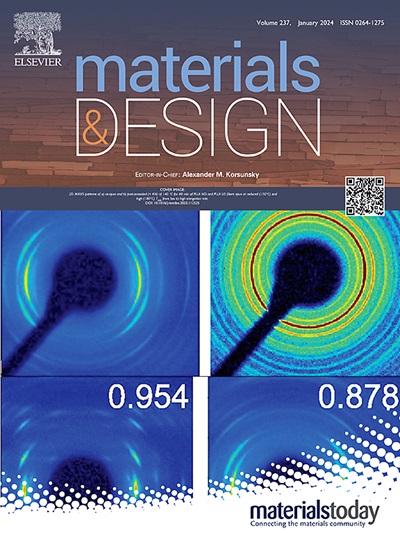Mechanical and fatigue performance of multidirectional functionally graded Ti6Al4V scaffolds produced via laser powder bed fusion for orthopedic implants
IF 7.6
2区 材料科学
Q1 MATERIALS SCIENCE, MULTIDISCIPLINARY
引用次数: 0
Abstract
Orthopedic implants require porosity gradients to achieve tissue integration and mechanical support. This study presents a novel design of Multidirectional Functionally Graded (MDFG) porous Ti6Al4V scaffolds, fabricated via Laser Powder Bed Fusion (LPBF) to mimic natural bone porosity for orthopedic applications. Four scaffold types were developed: Gyroid and Primitive (sheet-based TPMS) and Kelvin and Voronoi (strut-based lattices). A pore size of 1000 µm was maintained to promote tissue ingrowth, while strut thickness grading (0.3–0.7 mm) enhanced mechanical stability. Quasi-static compression tests showed Young’s moduli of 9.5 GPa (Gyroid) and 9.3 GPa (Primitive), with ultimate strengths of 240 MPa and 190 MPa, respectively. Energy absorption was 47.74 MJ/m3 for Gyroid and 46.68 MJ/m3 for Primitive, demonstrating excellent resistance to mechanical failure. Fatigue testing revealed that the Gyroid lattice sustained 25 MPa after one million cycles, highlighting its long-term durability. Fractographic analysis showed that fatigue cracks initiated at surface defects and propagated along strut intersections, providing insights into failure mechanisms. These findings confirm that MDFG scaffolds, particularly Gyroid and Primitive lattices, enhance mechanical robustness and biological compatibility, making them strong candidates for load-bearing orthopedic implants.

求助全文
约1分钟内获得全文
求助全文
来源期刊

Materials & Design
Engineering-Mechanical Engineering
CiteScore
14.30
自引率
7.10%
发文量
1028
审稿时长
85 days
期刊介绍:
Materials and Design is a multi-disciplinary journal that publishes original research reports, review articles, and express communications. The journal focuses on studying the structure and properties of inorganic and organic materials, advancements in synthesis, processing, characterization, and testing, the design of materials and engineering systems, and their applications in technology. It aims to bring together various aspects of materials science, engineering, physics, and chemistry.
The journal explores themes ranging from materials to design and aims to reveal the connections between natural and artificial materials, as well as experiment and modeling. Manuscripts submitted to Materials and Design should contain elements of discovery and surprise, as they often contribute new insights into the architecture and function of matter.
 求助内容:
求助内容: 应助结果提醒方式:
应助结果提醒方式:


